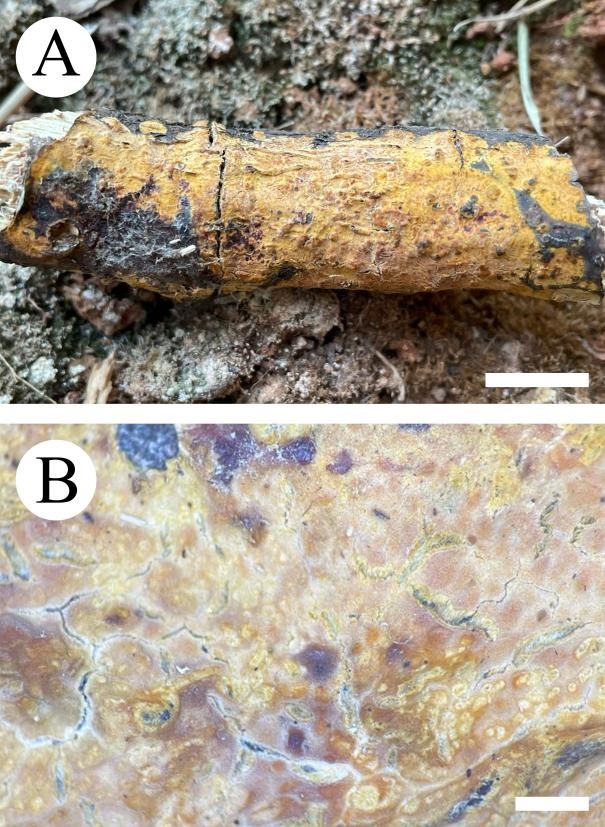Crustodontia rhododendri Authority.
MycoBank number: MB 843312; Index Fungorum number: IF 843312; Facesoffungi number: FoF 12679;
Description
Basidiomata annual, resupinate, ceraceous, without odor or taste, when fresh, becoming coriaceous upon drying, up to 5.5 cm long, 2 cm wide, 100–300 µm thick. Hymenial surface tuberculate, buff when fresh, straw to ochreous upon drying, cracking; turning to reddish or purplish immediately with KOH. Sterile margin narrow, 1 mm wide, slightly ochreous, fimbriate. Hyphal structure monomitic; generative hyphae clamped, colorless, thin-walled, unbranched, IKI–, CB–; tissues unchanged in KOH. Subicular hyphae subparallel, 3.5–5.5 µm in diameter; subhymenial hyphae unbranched, 2–5 µm in diameter; the presence of numerous yellow to yellowish brown gelatinous substances between subiculum and subhymenium. Hymenium cystidia cylindrical to ventricose, colorless, thin-walled, 17.5–40 × 2.7–5.4 µm; basidia cylindrical, with four sterigmata and a basal clamp connection, 10.3–33.4 × 3.3–5.6 µm. Basidiospores ellipsoid, colorless, thin-walled, smooth, often with 1–oil drops, IKI–, CB–, (35–)3.7–5.2(–5.5) × 1.9–2.9(–3.1) µm, L = 4.25 µm, W = 2.37 µm, Q = 1.68–1.87 (n = 360/12).
Material examined: China,, Yunnan Province, Puer, Zhenyuan County, Damoshan, E 101°37′, N 24°19′, alt. 1900 m, on fallen branch of Rhododendron simii, 15 January 2018, C.L. Zhao, CLZhao 6168 (SWFC).
Distribution: The species is known from southern China, growing in subtropical evergreen broad-leaved forests and has white rot.
Sequence data: ITS: MW732400 (ITS5/ITS4); LSU: MW724792 (LROR/LR7); RPB1: ON950240 (RPB1-Af/RPB1-Cr); EF1a: ON892523 (EF1-983F/EF1-2218R); GAPDH: ON892530 (GAPDH-F/GAPDH-R)
Notes: Crustodontia rhododendri is sister to C. chrysocreas (Berk. & M.A. Curtis) Hjortstam & Ryvarden and then grouped with C. tongxiniana (C.L. Zhao) C.C. Chen & Sheng H. Wu (Fig. 2), but morphologically C. chrysocreas differs in its pruinose hymenophore with the greyish ochraceous hymenial surface covering orange tint, capitate cystidia with pale brownish or yellow encrustations, and slightly thick-walled basidiospores (Berkeley 1873); C. tongxiniana differs in its smooth hymenophore with buff to cinnamon-buff hymenial surface, and wider basidiospores measuring as 4.5–5.5 × 2.8–3.5 µm (Huang & Zhao 2020).

Fig. 1 Basidioma of Crustodontia rhododendri (holotype). — Scale bars: A = 1 cm, B = 1 mm.

Fig. 2 Microscopic structures of Crustodontia rhododendri (drawn from the holotype). A. Basidiospores; B. Basidia and basidioles; C. Cystidioles; D. A section of hymenium. —Scale bars: A = 5 μm, B–D = 10 μm.
